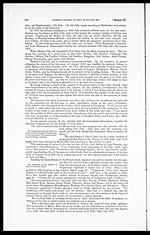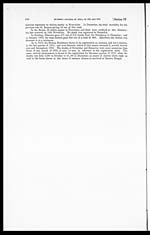Medicine - Institutions > Army health reports and medical documents > Vital statistics of India. Vol. V, Reports of 1876 on armies & jails and on epidemic cholera > Section IV - Cholera history of 1875 and 1876, illustrating how the area of Hindostan when unoccupied is re-invaded by epidemic cholera > Chapter IV - Cholera of the monsoon of 1875
(317) Page 295
Download files
Individual page:
Thumbnail gallery: Grid view | List view

295
Chapter IV.]
THE GEOGRAPHY OF THE MONSOON CHOLERA OF 1875.
The material adapted for invasion is not wanting in these years of exemption; we find
cholera in full epidemic vigour in the areas occupied in the spring, and taking up as much of
new ground as is permitted to it. The vehicle may be wanting, and without a vehicle cholera
does not move; or the body of cholera may already have been diverted elsewhere, and the
sweep of the monsoon over a tract from which cholera has been so removed conveys no material
for an epidemic to regions beyond. Every epidemic movement during the course of advance
lessens the chance of attack in a special locality. In 1869, Meean Meer had not a single cholera
admission; and in 1875 an attempt of cholera to establish itself on 20th October was abortive.
In my report of 1872 the subject is thus alluded to:
"It is more than remarkable to find that in three great epidemics the outbreak at Meean
Meer should have commenced almost on the same day, the 7th August in 1856, the 6th August
in 1861, and the 5th August in 1872. These facts show that, on empirical grounds alone,
the Sanitary Commissioner was warranted in representing to Government, as he did in June
1869, that the occurrence of a single case of cholera in Meean Meer in the last week of July
or first week of August, such as occurred this year on 1st August, should be followed by the
immediate evacuation of the cantonment."
In August 1875, as in August 1869, the Government of India asked my opinion as to the
course which the cholera in active progress over Northern India was likely to follow. My
note on the subject, handed to Government on 17th August, I shall quote afterwards.
The cholera of 1875 failed to strike Meean Meer, and failed to occupy Lahore; this great
city registered but 37 deaths in all, and the mortality commenced on 27th August, a date on
which a fresh appearance of cholera occurred over a wide tract. But the shadow was not want-
ing. On 1st, 3rd, and 4th August, the Civil Surgeon notes the fact that four cases of true
cholera did occur in the city, and that a clear interval of 22 days elapsed before the cholera
again showed itself.
The shadow at Lahore was represented by a substantial movement affecting Amritsar.
This cholera began at Amritsar on 21st July, and 800 people died before the close of the epi-
demic in October.
While Meean Meer to the west escaped, the Umballa cantonment in the east of the Pun-
jab became affected on 3rd August, perhaps for the very reason that the cholera which under
other conditions would have expended itself 120 miles to the west in the same week was here
stopped short in its westward course.
The first case in cantonments occurred on 30th July, and the outbreak in the Rifle Brigade,
which had 33 cases of cholera, culminated on 5th August.
The movement of 20th June, affecting the Himalayas from Kangra to Ghurwal, had ap-
propriated much of the material, which, but for this movement, would in August have
affected some at least of the districts which I have noted as escaping in 1875. This
Himalayan cholera could not make a retrograde movement on the Punjab, and, therefore, it
was expended on the districts already occupied. What became of this Punjab cholera of 1875
I shall show in the next Chapter.
The homologous phenomenon of
the affection of the British Soldier
taken as a type, in the Armies of the
tree Presidencies.
The Umballa outbreak was representative of the vast movement which we have traced
from Amritsar to Madras City; the cholera of this week, mov-
ing over Madras, Bombay, the Berars, the Central Provinces
and Upper India was in homological relation one and the same.
We read the fact, even when taking as a type our few
Europeans Troops dispersed over the great continent of India.
These are the dates of the commencement of outbreaks—Dhurmsala, August 13th; Muttra,
August 4th; Fort Gwalior, August 11th; Nowgong, August 13th; Lucknow, August 7th.
Ten days after, come—Delhi, August 21st; Morar, August 23rd; Ferozepore, August 24th;
and Meerut, August 27th. Or to take the Bombay and Madras Presidencies—Neemuch, July
28th; Ahmednagar, July 31st; Poona, August 8th; Kirkee, August 11th; Mhow, August
14th; and Madras, August 24th.
Renewed activity in Upper India
at dates subsequent to the first week
of August.
Following upon this cholera of August in Upper India came, in the first week of Septem-
ber 1875, a secondary movement of cholera, a phenomenon to
which frequent allusion has been made in writing the history of
other epidemics.*In this the Sialkot district was first entered,
a movement of importance as suggesting further advance into the Cashmere territory beyond.
Various corps in Meerut. Moradabad, Lucknow and Fyzabad, were first affected in this week.
The deaths of the cholera of 1875
in Upper, Central, and Western India,
while it remained in vital activity in
the extreme south.
The deaths of the Punjab declined to 129 in November and to 1 in December. The Gur-
daspur district retained its cholera longest, giving in No-
vember 85 out of the total of 129.
South of the Jumna cholera was dead in the same months.
No death was registered after October.
Cholera was threatening again to appear in Goruckpore and Busti, but in the other dis-
tricts in the east of the North-Western Provinces, 68 deaths only appear in November and 7
in December. In the Western Division, Bareilly, Shahjehanpore, Budaun, and Bijnor con-
tinued in the early part of November to register cholera deaths, giving 585 deaths out of a
total, for the area, of 700. The total mortality declined to 103 in December.
In the Central Provinces, Raipore and Bhandara still retained in November the cholera of
the year, giving 121 deaths; the districts to the south, Chanda and Wardha, gave 80 deaths;
and Betul, Hoshungabad, and Nimar gave the remainder for the province,—36 deaths. Thirteen
*See pages 33 to 36 of the Report for 1869.
Set display mode to: Large image | Zoom image | Transcription
Images and transcriptions on this page, including medium image downloads, may be used under the Creative Commons Attribution 4.0 International Licence unless otherwise stated. ![]()
| Permanent URL | https://digital.nls.uk/74994240 |
|---|




